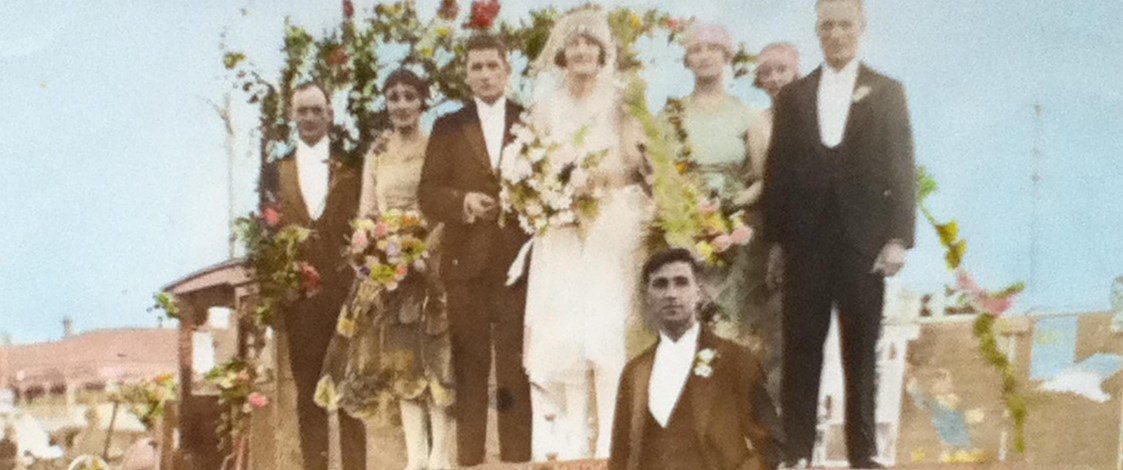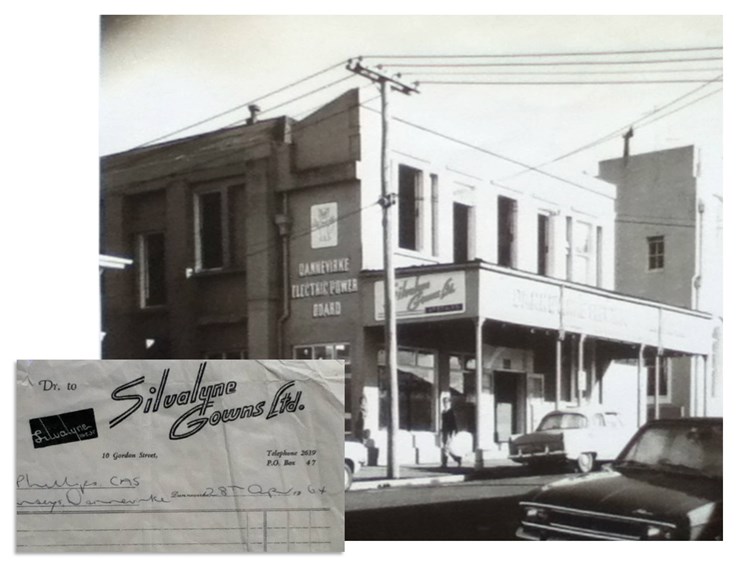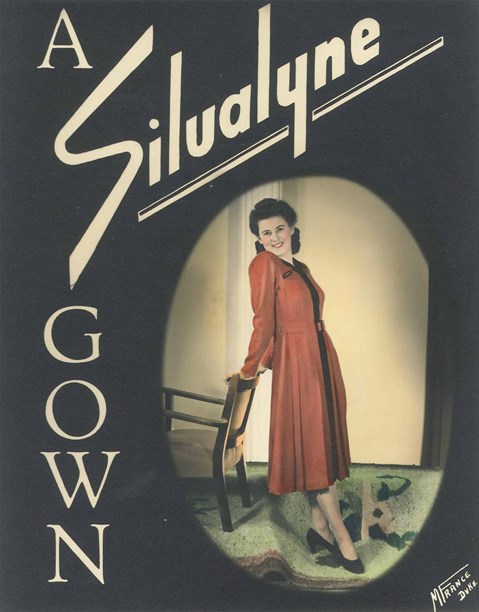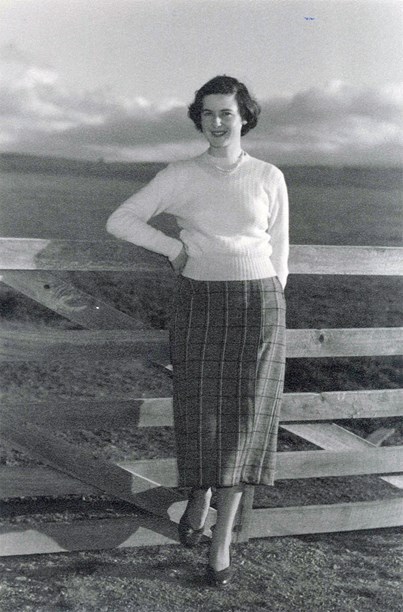Stories
Silvalyne Gowns
1903–1998 (Norman Alexander)

For young immigrant Norman Alexander, Dannevirke in 1927 was a style opportunity waiting to be served – the perfect place to establish a fashion label and a high street retail outlet.
Born in Lebanon in 1903, Norman's story was shaped by war and emigration. He was at school just five miles from Beirut when World War One broke out. The Middle East was then under Turkish control, and along with hundreds of other boys, Norman was taken out of school to build roads for the occupying Turkish Army, following a recent pact with Germany. It was hard, brutal work, involving breaking rocks until they were the size of an egg and causing the young boys to become witness to the harsh realities of war.
When, in 1918, the liberating British-Allied troops marched into Jerusalem, Norman – along with a group of his friends – went to meet them and offer their services. Over the next 11 months he assisted the Allies and became part of the irregular army marching in to Tripoli. Following the war, Norman returned to his hometown but soon decided to emigrate due to widespread poverty. One of his brothers had served in the New Zealand Army and in 1924 he joined him in New Zealand.
It is not known exactly what prompted Norman's interest in fashion design and retail. On arriving in New Zealand he travelled the lower half of the North Island in a very determined attempt to establish a fashion business, carrying a suitcase of garment samples and walking between towns to secure orders from retail outlets. By 1927 Norman had opened a high street store in Dannevirke called The Fashion.

Silvalyne Gowns, Dannevirke. Image courtesy of Dannevirke Gallery of History Archive.
The Fashion began as a ladies outfitter and frock specialist, and immediately Norman's approach was to accommodate the needs of the more fashionably dressed women of Dannevirke and surrounding districts. Initially, the emphasis at The Fashion was on imported garments in the ‘modes of the moment’, which were inspired by the “leading fashion salons of Paris, London and New York”. But Norman soon saw an opportunity to extend the business and to make use of the design and sewing skills of several local women.
A decade later, Norman opened a small factory warehouse. To begin with it was located behind his house, but by the 1940s the factory required larger premises. The new location was upstairs in Gordon Street, above the Dannevirke Electric Power Board. The garments it produced were marketed under the Silvalyne Gowns brand and distributed to retailers across New Zealand. It was a large business for a rural town. When a fire broke out in the building in 1953, the local newspaper reported that Silvalyne Gowns employed 14 staff members, with Norman working as managing director. The Dannevirke store employed another five shop assistants, a manageress, office girl and a trained corsetiere. There was also a designer and a beading specialist based at the factory.
At a time when stores such as The Fashion acted not just as aspiration but also as inspiration, specialist skills such as garment design and beading were very important. Such businesses operated within an economy that was both domestic and commercial – many women could sew the garments they aspired to, and yet the women working for Norman were paid for skills that they had initially developed within the home.
It was important for Norman to differentiate his products from these those available to home dressmakers. It was the quality of fabrics and trimmings, as well as features such as beading, that helped to distinguish a Silvalyne Gown.
Advertising emphasised these attributes. While early promotions made much of international influences, after World War Two, photographic campaigns employed live models rather than sketches. These were displayed in-store and in print and, in contrast to the text-heavy newspaper advertising, used visual narrative to present a clear sense of a healthy, homely and settled post-war life. They also offered scrutiny of the tailoring and fabrics that Silvalyne Gowns was known for.

Advertisement for a Silvalyne Gown. Image courtesy of Dannevirke Gallery of History Archive.
Choosing to locate garments in a rural setting would of course have had particular resonance for Norman's clients, and foregrounds a popular trope of fashion photography in rural settings, that continues in wide use today. While the image of Norman's garments placed in a farm setting may seem overly simplistic, they present a kind of freshness and invigoration of climate that links the farm-based production of wool with the end result of the supply chain. They show that these garments are made of good quality wool, they’re warm and ideal for the fashionably dressed woman of the country or the town.
Perhaps what is most significant is that Norman was selling his ‘made-in-Dannevirke’ garments to numerous outlets across New Zealand. By 1945 he had opened a new branch store, established on Broadway, in the much larger town of Palmerston North. In a sense Alexander was bringing the country to the town by designing and manufacturing in a small rural town and by using advertising that emphasised the qualities to be found in country dressing. This was in direct contrast to his early advertising for The Fashion, that had emphasised designs modelled on those available internationally. In that earlier context, his promotions brought the town (or the city) to the country.

Nancy Irvine modelling for Silvalyne Gowns. Image courtesy of Dannevirke Gallery of History Archive.
When he closed his retail store in 1975, Norman continued to supply Silvalyne Gowns to women across New Zealand. It’s an important distinction to note: that whether you are in town or in the country is always a relative position. Today, Dannevirke seems a quintessential country town; yet for many women during the time that Norman ran his business, coming ‘to town’ meant visiting shops just like The Fashion.
Although Norman retired and closed his business before the impact of deregulation in the fashion industry began to sweep New Zealand in the 1980s, his story carries similarities to that of many small businesses operating out of regional towns throughout New Zealand. They employed local women to supply fashions well beyond their local rural region. This begs the question: through his work at The Fashion and Silvalyne Gowns – Was he bringing the country to the town or the town to the country?
Text by Tanya Zoe Robinson. Banner image of Norman Alexander in front of a display for his retail store, The Fashion, at the Dannevirke A&P show, 1927. Image courtesy of Dannevirke Gallery of History Archive.
Last published June 2015.